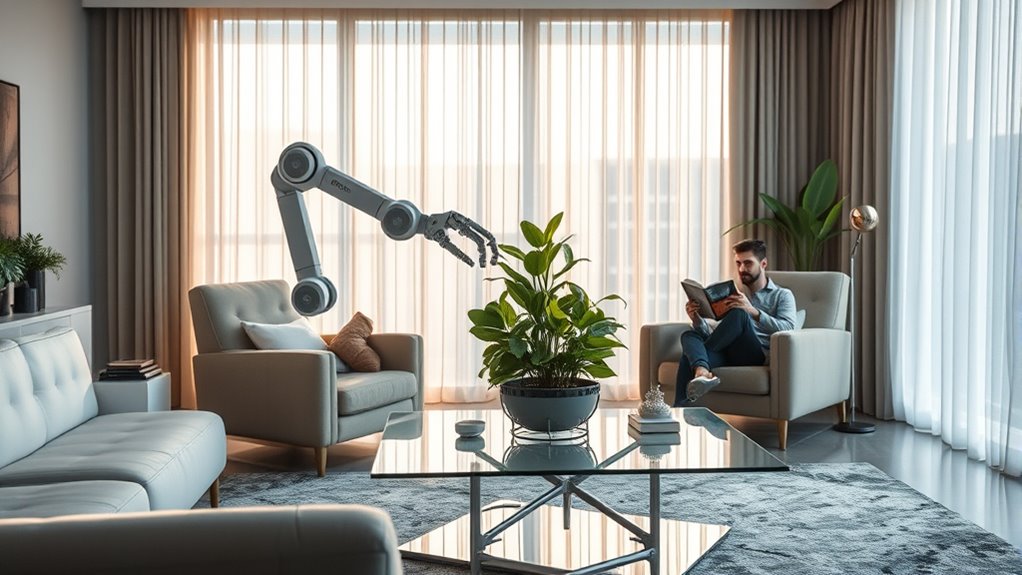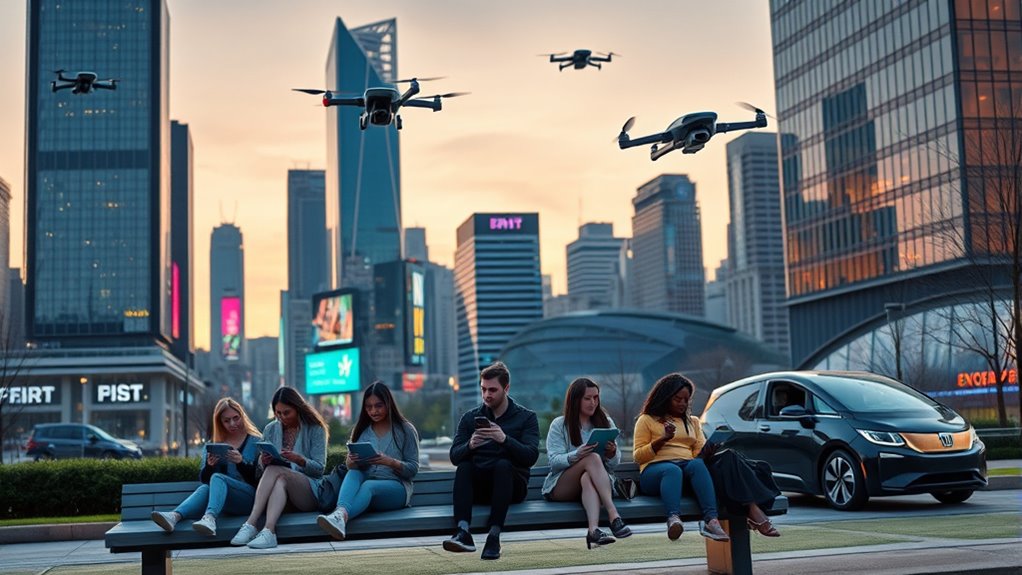Automation promises more leisure time, but in reality, it often leads to longer work hours because workers and employers benefit from increased productivity through higher wages, bonuses, or organizational growth. Instead of working less, many end up working more to earn extra income or keep their jobs, especially as automation shifts tasks but doesn’t always reduce overall workload. If you want to understand how these trends really play out and what might change, keep exploring.
Key Takeaways
- Automation tends to increase work hours through productivity gains, as employers reinvest efficiency into growth or longer hours.
- Workers often work longer hours for higher wages, bonuses, and career benefits, offsetting potential leisure time gains.
- Increased automation can free up time for active leisure and hobbies, but rising screen time and social habits may limit outdoor activity.
- Longer workweeks driven by market incentives reduce non-screen and passive leisure activities despite automation benefits.
- Policy and cultural shifts are necessary to translate automation-driven productivity into genuine leisure time for most workers.
The Impact of AI on Weekly Work Hours

How exactly is AI changing your weekly work hours? In high AI-exposure jobs, you’re likely working about 3.15 hours more each week since ChatGPT’s debut. If you’re in the 25th to 75th percentile for AI exposure, expect around 2.2 extra hours weekly. While AI boosts productivity, it often encourages longer hours because each hour becomes more valuable. Instead of taking more time off, many workers choose to work longer to earn extra income. Surprisingly, AI could save some people up to 12 hours a week, but overall, work hours tend to increase due to productivity incentives. This trend is especially evident when considering the performance metrics used to evaluate efficiency and output. Regional legal resources and understanding local employment trends can help explain some of these shifts. The paradox of AI is that despite its potential to reduce workload, it often leads to longer working hours. So, even as AI makes work more efficient, many end up dedicating more time to their jobs, reducing leisure, especially active non-screen activities. Additionally, the influence of dog breeds on workplace stress and well-being is an area of emerging research, highlighting how companion animals can positively affect mental health during work hours. Moreover, the impact of technology integration in workplaces can further influence work hours and employee satisfaction.
How Automation Is Changing Leisure Activities

Automation is transforming how you spend your free time, making active leisure more accessible and convenient. With more chores handled automatically, you have more opportunities for sports, outdoor activities, or social hobbies. At the same time, screen-based engagement like gaming and streaming continues to grow, offering new ways to relax indoors. Potential for automation of domestic tasks suggests that a significant portion of household chores could soon be automated, freeing up even more leisure time. Additionally, advancements in AI Security help ensure that these automated systems remain safe and trustworthy for everyday use. The integration of privacy policies and clear user consent management further enhances user trust in automated systems. Incorporating yoga practices into daily routines can further enhance mental and physical well-being, making leisure time more fulfilling.
Shifts in Active Leisure
As automation advances, it’s transforming the way you spend your leisure time by reducing work hours and freeing up more opportunities for active pursuits. You might explore new hobbies, participate in more social activities, or focus on health and wellness. Automation also redistributes tasks, allowing you to engage in creative or social leisure that wasn’t possible before. Additionally, juice detox like customization and accessibility can enhance leisure experiences. However, some regions experience less benefit, and increased monitoring can blur work-life boundaries. Here’s a quick look at how automation influences active leisure:
| Impact | Description | Examples |
|---|---|---|
| More Free Time | Reduced work hours create active leisure opportunities | Sports, outdoor adventures |
| Task Redistribution | Shifts enable more creative/social activities | Group fitness, hobbies |
| Regional Variations | Geographic differences affect leisure benefits | Urban vs. rural differences |
| Economic Impact | Benefits depend on fair compensation for time saved | Paid time off, incentives |
Automation can also influence hours of operation at local venues, impacting how and when you can enjoy your leisure activities. Moreover, increased automation-driven productivity can lead to longer-term economic benefits, potentially expanding leisure options even further.
Screen-Based Engagement Rise
Digital devices have become the primary way people engage with leisure activities, especially among youth and adults alike. Nearly all teenagers, with 88–95% of 13–18-year-olds, spend free time on screens, and 31% of 8-year-olds own their own device. For teens, most leisure is now digitally mediated, and adults also spend significant portions of their free time on screens. Device ownership is rising among children, making screen-based leisure increasingly common. Over time, daily screen time has steadily grown—more TV, computers, and video games—shaping how you relax and socialize. This digital shift often replaces active pursuits, making leisure less physically engaging. As automation and digital devices evolve, your leisure activities become more personalized and habitual, deeply embedding screens into everyday life. Research indicates that this trend can influence attention spans and social skills over time, potentially affecting overall well-being. Additionally, the pervasiveness of screens can lead to decreased outdoor activity and physical exercise, further impacting health.
The Economic Incentives Behind Longer Work Hours

You might notice that working longer hours often leads to higher wages and better career prospects. As productivity improves, workers are motivated to put in extra time to earn bonuses or promotions. These economic incentives keep many pushing beyond standard hours, even as automation changes the nature of work. Recent trends show that longer hours are increasingly associated with increased earnings, encouraging workers to dedicate more time regardless of technological advances. Additionally, workplace cultures and performance expectations often reinforce the desire to work beyond normal hours to demonstrate commitment and secure job stability. This pattern is further supported by the business environment, which tends to prioritize output and results over work-life balance. Moreover, some employers may expect employees to accommodate extended work hours as part of their professional routine, further reinforcing this tendency. The persistent drive for economic gains continues to influence workers’ decisions to work longer hours despite automation’s potential to reduce workload. Furthermore, the labor market dynamics often make it difficult for workers to refuse additional hours due to job security concerns.
Productivity Gains Drive Workload
Although increased productivity might suggest that workers could enjoy more leisure time, economic incentives often drive them to work longer hours instead. Higher productivity doesn’t automatically mean fewer hours; in fact, in many cases, total work hours stay the same or even increase. The main drivers are the substitution effect—where higher productivity raises the relative cost of leisure— and the income effect—where workers can afford more leisure but choose to work longer. Data from the US and other countries show that productivity gains often lead to expanded workloads, not shorter workweeks. Employers tend to reinvest productivity improvements into business growth, increased services, or longer hours, rather than reducing hours. Market pressures and organizational practices reinforce this cycle, keeping workloads high despite technological advances.
Wages Encourage Extended Hours
Wages play a significant role in encouraging workers to extend their hours, as higher pay rates provide strong financial motivation. When overtime pays 1.5 to 2 times the regular rate, you’re more likely to work extra hours to boost your income. Increased wages improve your economic stability and purchasing power, making longer hours attractive. Financial incentives like bonuses or additional pay motivate you to stay longer on the job. Stable income from extended hours offers a sense of security, encouraging you to keep working. Additionally, higher wages can lead to increased productivity and economic growth by raising demand for labor. Many workers also take on multiple jobs or work nonstandard hours to maximize earnings, driven by the desire for better financial rewards.
Job Displacement Risks and Workforce Adaptation

As automation continues to reshape industries, a substantial portion of the workforce faces displacement risks, especially in roles with repetitive and routine tasks. About 12.6% of U.S. workers, roughly 1 in 8, are highly exposed, with sectors like energy, utilities, and mining seeing over 46.5% at risk by 2030. While roughly 14% of workers have already experienced job displacement, many employers are investing heavily in reskilling—77% in 2025—to help workers adapt. Success depends on developing skills in problem-solving, creativity, and interpersonal areas. However, the impact varies across sectors and regions, as shown below:
| Sector | Displacement Risk (%) |
|---|---|
| Energy, Utilities, Mining | 46.5 |
| Manufacturing | Rapid growth in robotics |
| Customer Service | Increasing AI adoption |
| Creative & Knowledge | Lower displacement risk |
| Geographic Regions | Varies considerably |
Business Strategies for Productivity and Employee Well-Being

To effectively boost productivity and enhance employee well-being through automation, businesses must align their strategies with overall organizational goals and foster strong collaboration across departments. Engage partners across sales, marketing, IT, and customer service to identify automation initiatives that deliver the highest value. Cultivate “business intimacy” by understanding each department’s needs and strategic priorities, ensuring automation efforts support core objectives. Avoid developing siloed solutions that miss the bigger picture. Prioritize projects that impact key performance indicators and stay within budget. Collaborate closely to ensure technology investments improve enterprise-wide efficiency and employee satisfaction. Automating routine tasks like scheduling, invoicing, and data entry frees employees to focus on higher-value work, reducing burnout and boosting overall morale. This alignment creates a foundation for sustainable productivity and a healthier work environment.
The Future of Work and Leisure in an Automated World

Automation is transforming how you work and spend your leisure time, often extending work hours despite promises of shorter, more relaxed schedules. Nearly half of your current tasks could be automated, boosting productivity but also encouraging longer hours. As machines handle routine work, humans focus on oversight and complex decisions, but this often leads to increased work demands. By 2025, automation may disrupt 85 million jobs globally, spreading across industries and blurring the line between human and machine labor. While productivity rises, many workers experience up to 80% of their time doing tasks that add little value, leaving little room for leisure. Higher exposure to AI correlates with longer workweeks, reducing non-screen leisure activities and shifting downtime toward passive, isolated pursuits. The future isn’t necessarily more leisure-filled; it’s more complex and demanding.
Policy and Cultural Shifts Needed for True Leisure Gains

Realizing genuine leisure gains from automation requires deliberate policy and cultural shifts. Policies must support work redistribution, like shorter hours or flexible schedules, to convert productivity into leisure. Cultural norms need to evolve, moving away from equating work with worth and embracing leisure as valuable. Without such shifts, higher productivity often leads to longer hours rather than more free time. The table below shows how policy and cultural changes align to maximize leisure:
| Policy Changes | Cultural Shifts | Economic Incentives |
|---|---|---|
| Promote equitable income sharing | Reframe work as a source of wellbeing | Incentivize shorter workweeks |
| Support flexible work arrangements | Shift norms to value leisure | Retrain workers for automation roles |
| Implement minimum leisure guarantees | Normalize leisure as purposeful | Adjust incentives to prioritize leisure over extended hours |
Frequently Asked Questions
Will Automation Reduce Overall Unemployment or Just Shift Job Roles?
You wonder if automation will cut overall unemployment or just change job roles. Automation displaces some jobs, but it also creates new ones, especially in tech and AI-related fields. As machines handle routine tasks, you’ll need to adapt by retraining. While some roles fade, others emerge, shifting employment rather than eliminating it entirely. Embracing ongoing learning helps you stay relevant in a transforming job market.
How Do Automation-Driven Productivity Gains Impact Income Inequality?
Automation-driven productivity gains tend to worsen income inequality because the benefits mostly go to capital owners and high-skilled workers. You may see wages stagnate or decline for lower-skilled workers, while wealth concentrates among the already wealthy. Instead of distributing gains broadly, automation often amplifies existing economic gaps, making it harder for you and others in lower-income brackets to share in the productivity improvements.
Can Policy Changes Effectively Convert Productivity Into Genuine Leisure Time?
Think of productivity as a river flowing steadily; policy changes are like dams controlling its flow. You can harness this current to create more leisure time, much like recent remote work policies have done by reducing commutes. Data shows leisure time has increased over decades, suggesting policies can direct productivity toward more free time. With targeted reforms, you can guarantee everyone benefits from this flow, making leisure truly more accessible and genuine.
What Are the Mental Health Implications of Increased Work Hours Due to AI?
You might notice that increased work hours due to AI can negatively impact your mental health. Longer hours may lead to stress, burnout, and feelings of anxiety or depression. Reduced leisure time also means less social interaction and relaxation, which are crucial for mental well-being. As AI blurs work-life boundaries, you could feel more overwhelmed, so it’s vital to find ways to manage workload and prioritize self-care.
Will Future AI Advancements Make Leisure Time More Accessible or More Fragmented?
Like a double-edged sword, AI can make leisure time more accessible yet also fragment it. You might enjoy personalized, effortless activities, but your leisure could shift toward constant screen time, reducing social interaction. AI’s convenience can broaden your options, yet over-reliance might limit new experiences. Ultimately, AI’s impact depends on how you choose to balance its benefits with potential downsides, shaping your leisure in both enriching and challenging ways.
Conclusion
While automation promises more leisure time, the reality is complex. Currently, Americans work about 1.5 hours more per week than in the 1970s, despite advances in technology. If policies and business strategies don’t prioritize work-life balance, automation might just extend work hours instead of freeing your time. To truly benefit, you’ll need societal shifts that value leisure and support workers through the evolution—otherwise, automation may not deliver the leisure revolution many hope for.









